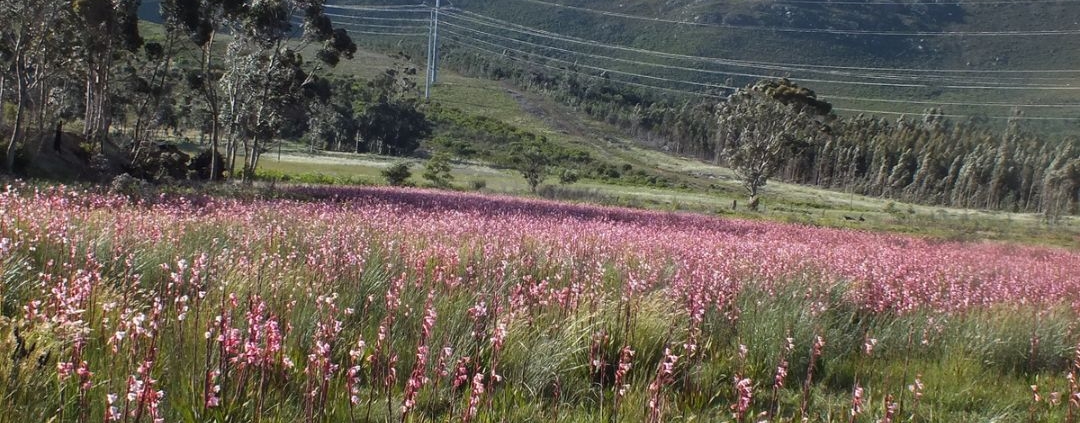From the Archives: Newsletter January 2010
December 2010
Dear Sowers of seeds
As usual, we will start with the weather! In the Western Cape we had a similar weather pattern this year to last year – good rains in the SW Cape, but the fronts not reaching north or inland or along the south Cape coast. The area around Knysna and George is extremely dry and they are now enduring very strict water regulations. Our rains ended as normal, late in September, and we had some fiercely hot weather in October, followed by an incredibly wet November. In Kenilworth we received 220mm (almost 9 inches) of rain in 4 days, making it one of the wettest Novembers ever recorded. It became very cold and we were all back to winter woolies and huddling round fires! The Drakensberg Mountains and Lesotho had heavy falls of snow – not unheard of in November, but rather unusual. Our bulbs, all still outside drying off, didn’t know what had hit them!
We went north to Namibia in May this year and the desert was looking really good, as it does after reasonable summer rain. Just how good the rains were we didn’t realise until we arrived at the Brandberg Mountain, north of Windhoek. We normally access the mountain by means of a dry valley on the west side, and as we drove in, we were surprised to see that the normally bare dry landscape was green and lush with plants a meter high! On getting out of the car at our campsite, we noticed a noise – the normally dry river was flowing, and flowing strongly with beautiful crystal clear water. There was no evidence of flood damage and it appeared that the Brandberg (incidentally, the highest peak in Namibia at about 2 500m) had not had the usual thunder storms which bring rain in summer, but had had days and weeks of soft gentle rain. All the sponges on the mountain were full, and there were streams everywhere. Although not prepared for it, we decided that this was the one year we had to go up the mountain onto the plateau on top where the rainfall is higher and the vegetation different to that on the slopes. Normally the walk up is totally dry and the temperature is in the high 30°sC or low 40°sC. This means that one carries an extremely heavy rucksack with food, sleeping bags and all one’s water requirements, sometimes for 3 or 4 days. However, this time was rather a different scenario! The temperature was as high as usual, but we followed the river up, and stopped so many times for swims in large pools, some with glorious waterfalls, that we only got about two thirds of the way up before camping on a sand bank next to an extremely beautiful pool – a campsite in paradise (except for a full moon which shone in our eyes all night)! The next morning we reached the top, and spent the day botanising before washing under a waterfall and spending the night in a cave. The third day we went down back to our car. The ascent and descent of the mountain is quite dramatic – it is mainly by means of long granite slabs, often steeper than 45°, and sometimes hundreds of meters long. Going up one merely gets out of breath, but coming down really hammers the nerves (some of those slopes were really steep!), the knees and the calf muscles, and we finally reached the car tired, elated and much fitter! The next day we both had fairly stiff leg muscles, and by the 3rd day, we could hardly move our legs!
We decided not to squander our fitness by sitting around at home, and kept it up by going for long hard walks up Table Mountain and various other peaks around Cape Town. In late August we flew to Switzerland and spent a week walking in the Alps with a botanist friend, a first for both of us. We were lucky with the weather which was superb, as was the scenery and the alpine flowers, and we had a wonderful time walking with small day packs from Alpine hut to hut. From there we went to the Four Oaks Trade Fair near Manchester, and then on to Prague (and the beautiful botanic garden), followed by the Tatras Mountains in Slovakia were we walked every day. The walking was strenuous with superb scenery, forests which were just turning colour with autumn, and many lovely lakes.
On our return from Europe, we felt fit enough to tackle a walk that we thought we would never do again – the Hex River traverse. This is probably the finest mountain traverse in South Africa, but is not for the faint hearted! Route finding is complex with no paths, the days are dry and long, and there is no level walking at any time over the 4 day walk. The first day is a steep up, the last is a steep down, and the 2 days in between involve crossing numerous peaks, traversing round mountains and finding small necks to cross from one ridge to the next. We did the walk with Andy (our partner from Frontier Lab) and a friend of his – both of them in their 40s, 10 to 20 years younger than us. However, luckily for us they were not very fit, and our fitness made up for our advanced ages so we all walked at the same pace! We had a most enjoyable 4 days with superb weather – clear but cool with no wind. Every day brought something different and as it was late spring, the flowers were superb. Coming down a particularly steep and rocky slope, we found what we thought was an unusual species of Hesperantha with a showy bright pink flower and we could not recall ever seeing it before. Although we had no plant press with us, we took a specimen, pressed it in our map, and on our return to Cape Town, gave it to John Manning at the Compton Herbarium. He took one look at it, proclaimed it an Ixia not a Hesperantha, and said it is a new species! This is the second new Ixia species we have found on the same mountain in 12 months – one wonders what else lurks there!
Some of the burned areas close to Cape Town produced some marvelous floral displays from August onwards, and as we write this in November, they are still continuing. Part of Table Mountain burned last summer, and there have been successive sheets of flowers – Gladioli, Ixias, Ornithogalums, Lachenalias, Hesperanthas and Geissorhizas, Moraeas and now thousands of Watsonia borbonnica and Micranthus species. We have noticed that in the south of the country the best displays are often 4 to 6 weeks later than those further north.
Our staff compliment remains unchanged – everyone a year older, but still healthy and working hard. Rachel’s mother, now 91 and still working every day, has just had a slight accident in her car which upset her as it is the first accident she has ever had in over 70 years of driving!
Two of our cats – Squatter and Tabby, have become the best of friends, and even our ginger thug Zingiber, has mellowed a little with age!
Best Wishes
Rod & Rachel



